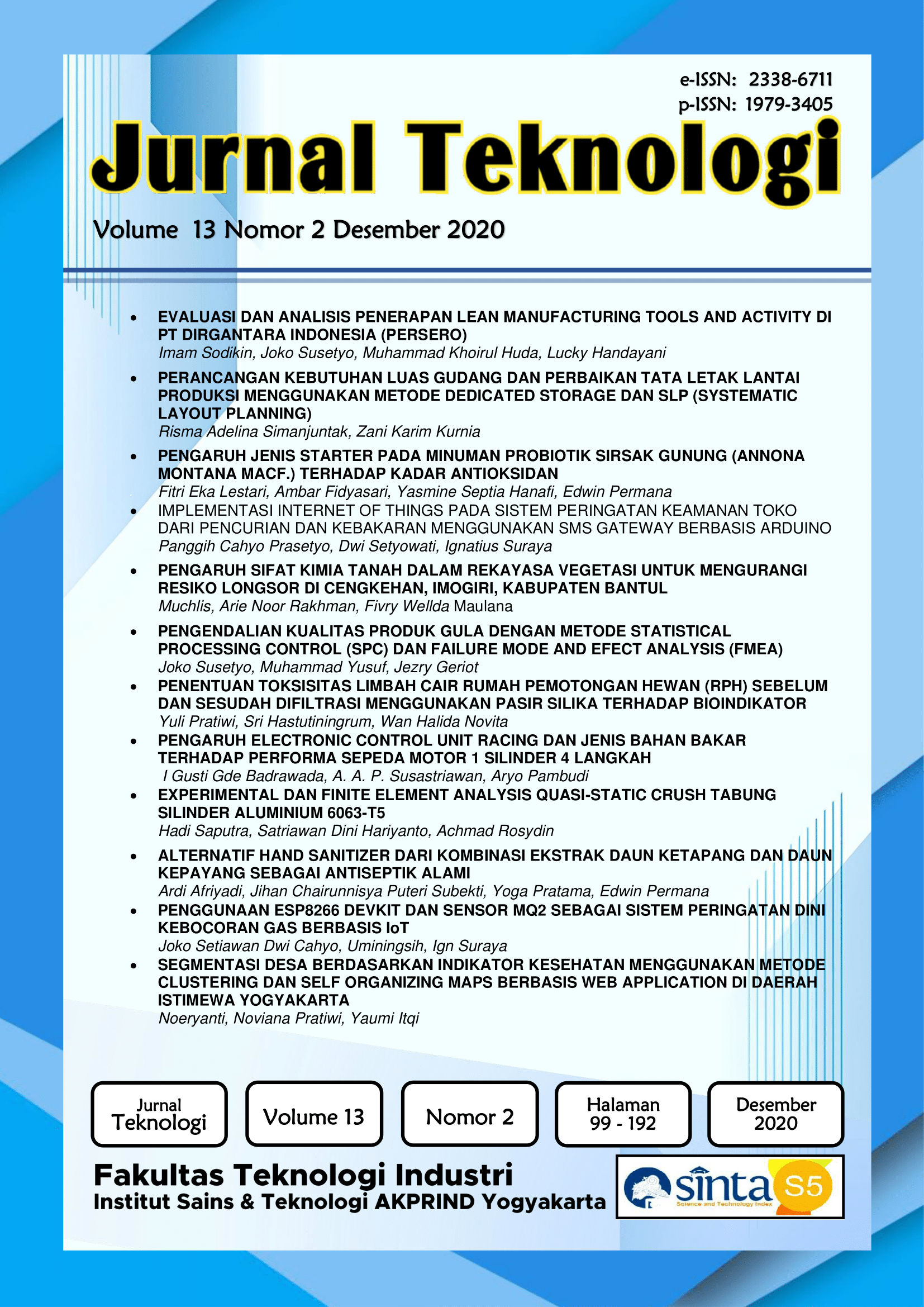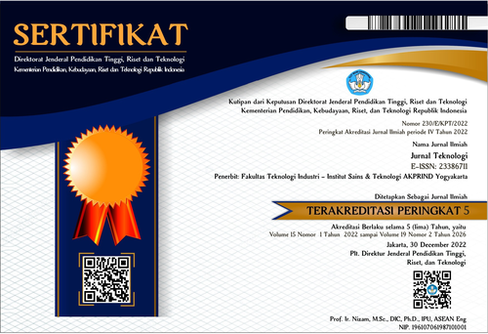EXPERIMENTAL DAN FINITE ELEMENT ANALYSIS QUASI-STATIC CRUSH TABUNG SILINDER ALUMINIUM 6063-T5
DOI:
https://doi.org/10.3415/jurtek.v13i2.3219Keywords:
Quasi-static crush, Aluminum silinder, Energi absorberAbstract
Energy absorber merupakan peralatan pengaman kendaraan yang diperlukan untuk melindungi penumpang kendaraan saat terjadi kecelakaan. Sejak awal tahun 1960 an, setelah Alexander memperkenalkan teorinya tentang penyerapan energi. Penemuan baru peralatan ini terus berkembang secara berkelanjutan. Bersamaan dengan berjalannya waktu, teori proses penyerapan energi pada peralatan ini juga terus dikembangkan oleh ilmuwan lainnya Tujuannya untuk memperoleh peralatan penyerap energi yang lebih baik. Sementara penelitian dibidang ini membutuhkan biaya yang tidak murah. Perkembangan teknologi komputer saat ini, analisa dengan metode elemen hingga dapat digunakan sebagai method alternatif. Persoalan yang ada terletak pada tingkat akurasi hasil simulasi bila dibandingkan dengan hasil percobaan. Hasil penelitian ini menunjukkan tingkat akurasi penggunaan teknologi simulasi baik. Hasil pengujian dan simulasi hampir sama, nilai penyerapan energi yang dihasikan maupun bentuk deformasi yang terjadi pada tabung silinder aluminium 6063-T5 dengan beban quasi-statics compresion crush menunjukkan hasil yang hampir sama.Downloads
References
Abramowicz, W. and Jones, N. (1984) ‘Dynamic Progressive Buckling of Square Tubes’, International Journal Impact Engineering, (December), pp. 243–270.
Abramowicz, W. and Jones, N. (1986) ‘Dynamic progressive buckling of circular and square tubes’, Journal of Impact Engineering, 4(4), pp. 243–270. Available at: http://dx.doi.org/1.0.1016/07.
Alexander, J. M. (1960) ‘An approximate analysis of the collapse of thin cylindrical shells under axial loading.’, The quarterly journal of mechanics and applied mathematics, 13(1), pp. 10–15. doi: https://doi.org/10.1093/qjmam/13.1.10.
Annonim (2019) Aluminium alloy, Wikipedia. Available at: https://en.wikipedia.org/wiki/6063_aluminium_alloy#6063-T5 (Accessed: 19 July 2020).
Brandenburg, S. et al. (2009) ‘Gemeinsame Empfehlung der AWMF und der DGUV in Zusammenarbeit mit der DGAUM und der DGSMP bei der Entwicklung von Leitlinien und Empfehlungen zur Begutachtung von Berufskrankheiten’, Arbeitsmedizin Sozialmedizin Umweltmedizin, 44(12), pp. 646–652.
Elsobky, H. and Singace, A. (1996) ‘Further Experimental Investigation on The Eccentricity Factor In The Progressive Crushing Tubes’, Journal of Solids and Strucutres, 33(24), pp. 3517–3538. Available at: http://dx.doi.org/10.1016/0020-7683(95)00195-6.
Ghamarian, A. and Tahaye Abadi, M. (2011) ‘Axial crushing analysis of end-capped circular tubes’, Thin-Walled Structures. Elsevier, 49(6), pp. 743–752. doi: 10.1016/j.tws.2011.01.006.
Guillow, S. R., Lu, G. and Grzebieta, R. H. (2001) ‘Quasi-static axial compression of thin-walled circular aluminium tubes’, International Journal of Mechanical Science, 43, pp. 2103–2123. Available at: http://dx.doi.org/10.1016/S0020-7403(01)00031-5.
Karagiozova, D., Alves, M. and Jones, N. (2000) ‘Inertia effects in axisymmetrically deformed cylindrical shells under axial impact’, International Journal of Impact Engineering, 24(10), pp. 1083–1115. doi: 10.1016/S0734-743X(00)00028-2.
Lu, G. and Yu, T. (2003) Energy absorption of structures and materials, Woodhead Publishing Limited, Abington Hall, Abington Cambridge CB1 6AH, England. Available at: www.woodhead-publishing.com.
Palanivelu, S. et al. (2011) ‘Low velocity axial impact crushing performance of empty recyclable metal beverage cans’, International Journal of Impact Engineering. Elsevier Ltd, 38(7), pp. 622–636. doi: 10.1016/j.ijimpeng.2011.02.008.
Singace, A. A. and El-Sobky, H. (1997) ‘Behaviour of axially crushed corrugated tubes’, International Journal of Mechanical Sciences, 39(3), pp. 249–268. Available at: http://dx.doi.org/10.1.016/S0020-7403(96)00022-7.
Singace, A. A., Elsobky, H. and Reddy, T. Y. (1995) ‘On the eccentricity factor in the progressive crushing of tubes’, International Journal of Solids and Structures. Elsevier Science Ltd, 32(24), pp. 3589–3602. doi: 10.1016/0020-7683(95)00020-B.
Wierbicki, T. and Bhat.S.U. (1986) ‘A moving hinge solution for axisymetric crushing of tubes’, International Journal of Mechanical Sciences, 28(3), pp. 135–151. Available at: http://dx/doi.org/10.1.01.6//0020-7403(86)90033-0.
Wierzbicki, T. et al. (1992) ‘A two folding elements model of progressive crushing of tubes’, International Journal of Solids and Structures, 29(1977), pp. 3269–3288. Available at: http://dx.doi.org/10.1016/002-7683(92)90040-z.
Wierzbicki, T. and Abramowicz, W. (1983) ‘On the crushing mechanics of thin walled structures’, Journal of Applied Mechanics (ASME). Available at: http://dx.doi.org/10.1.1.1.5/1.31.6713.
Wierzbicki, T., Recke, L. and Huang, J. (1994) ‘Stress profiles in thin-walled prismatic columns subjected to crush loading II. Bending’, Computers & Structures, 51(94), pp. 625–641. Available at: http://dx.doi.org/10.1016/S0045-7949(05)80002-1.
Yob, M. N. et al. (2015) ‘Quasi Static Axial Compression of Thin Walled Aluminum Tubes: Analysis of Flow Stress in the Analytical Models’, Modern Applied Science, 10(1), p. 34. doi: 10.5539/mas.v10n1p34.
Yuen, S. C. K. and Nurick, G. N. (2008) ‘The energy-absorbing characteristics of tubular structures with geometric and material modifications: An overview’, Applied Mechanics Reviews, 61(1–6), pp. 0208021–02080215. doi: 10.1115/1.2885138.
Zywicz, E. et al. (2012) ‘Thin-walled structures as impact energy absorbers’, Materials and Design. Elsevier Ltd, 2(1), pp. 1–6. doi: 10.1016/S0263-8231(02)00082-4.
Downloads
Published
How to Cite
Issue
Section
License

This work is licensed under a Creative Commons Attribution 4.0 International License.
Jurnal Teknologi provides immediate open access to its content in order of making research freely available to the public to support a global exchange of knowledge. All articles published in this journal are free for everyone to read and download, under licence CC BY SA.
Benefits of open access for the author, include:
- Free access for all users worldwide.
- Authors retain copyright to their work.
- Increased visibility and readership.
- No spatial constraints.




















